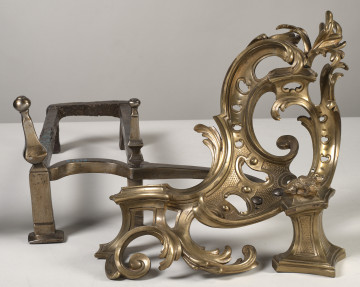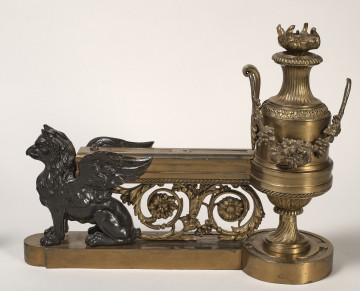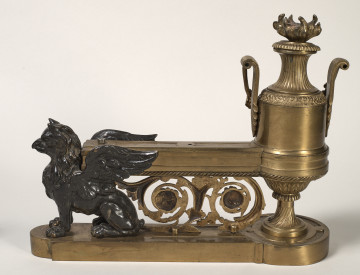
Fireplace wolf
18th century
Castle Museum in Łańcut
Part of the collection: Metals
Andiron The history of andirons, or firedogs, began in the Middle Ages, their prototype was a long rod of wrought iron with a hook for hanging a cauldron over a fire. In the 14th century, this bar was augmented by a shaft running deep into the hearth to support wooden logs, and from the 16th century on, a decorative function was added to the utilitarian function. The name “firedog” (in Poland the name “chimney wolf” was adopted) comes from English and French. The most common material used for firedogs was wrought iron, although in the late 17th century, silver and later bronze, often gilded, were common. The forms of the andirons changed with the current fashion and style, from very simple to very decorative. The andiron in question comes from the Potocki collection, from the second half of the 18th century, and is a French bronze product. It consists of a rectangular-shaped grate on four legs with additional decoration in the shape of rods ending in knobs. The decorative part in Louis XV style consisting of a stylised rocaille with acanthus leaves, and a seated putto with a book held in the left hand, the right hand raised. The putto is almost naked, with softly flowing fabric draped only on the hips, and a wreath of laurel leaves on its head.
Author / creator
Dimensions
height: 29 cm, width: 47 cm
Object type
Metals
Technique
cast, forging
Material
brass, iron
Creation time / dating
Creation / finding place
Owner
Castle Museum in Łańcut
Identification number
Location / status

18th century
Castle Museum in Łańcut

19th (?) century
Castle Museum in Łańcut

19th (?) century
Castle Museum in Łańcut
DISCOVER this TOPIC
Castle Museum in Łańcut
DISCOVER this PATH
Educational path